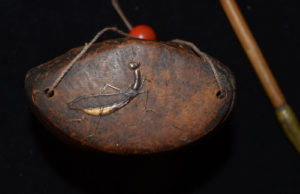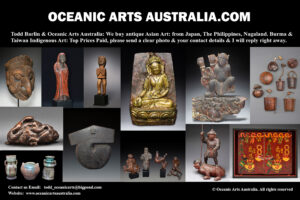A Fine Old Japanese Tobacco Case with Pipe Holder 19th Century
| Collection No. | T-4314 |
|---|---|
| Size | The Wood Tobacco Case 8 cm & Pipe Case is 20cm |
A Fine Old Japanese Tobacco Case with Pipe Holder 19th Century
This beautiful old Japanese Tobacco Case is carved from wood with lacquer-painted designs of incests, the front of the wood case has a grasshopper & a bee & the top of the case has a finely painted praying mantis insect. There is a small carved skull Ojime and the Pipe Holder is natural wood, the pipe is made from bronze & bamboo.
Some of the most beautiful small objects made in Japan were used for Tobacco Smoking. Their individual unique beauty, there is such variation from the most simple natural form burl wood containers to the elaborately carved wood examples with finely incised designs.
The Portuguese introduced tobacco in Japan in the second half of the sixteenth century. The Japanese were particularly surprised to see the Portuguese smoking pipes and spitting out smoke and would have exclaimed: “The Southern Barbarians have a fire in their belly!”
Tobacco was quickly adopted by the Japanese people by the end of the sixteenth century, the Kerisu or Smoking Pipes, were used as the only way to smoke tobacco in Japan and it would remain that way for the next three centuries, until the Meiji Restoration (1868), when cigarettes arrived in Japan and became very popular.
The smoking implements needed to smoke while outside or traveling were a set consisting of a pouch to hold the tobacco called TONKOTSU and the Pipe or Kerisu & its holder. Tobacco pouches were usually beautifully decorated and with delicate metal clasps to close the pouch, they also had a Netsuke on the end of a small chain or string so as to tuck into the traditional sash called (Obi). Japanese robes did not have pockets & which is why their tobacco smoking sets were tucked into their sash.
In the Edo period in Japan (1603-1868) and before the development of cigarettes in Japan was the heyday of Kiseru Pipes & Tobacco smoking paraphernalia. In the Edo period, there was in the high society a ” Tobacco Ceremony” or ” The Way of Tobacco” (tabako-dō 烟草道), similar to the Japanese “Tea Ceremony” where rules of politeness and decorum were fixed and there were procedures or good manners to give and receive the Kiseru pipes when smoking with the company.
It became very fashionable to have a fine Kiseru Pipe and beautiful Tobacco Case and it was an essential fashion accessory for young people from rich houses.
There is even a Kiseru Festival that happens every year on the first Sunday of September in Ibaraki region. The “Kiseru Matsuri” Ceremony in which men carry a huge Kiseru Pipe up to three meters long associated with Shinto rituals. This festival is held every year on Mount Kaba-san, in Ishioka since 1954, after the tobacco crops in the area were “miraculously” saved from heavy hail. A massive 3.5-meter Kiseru made of bamboo and tin by the peasants was then given as an offering at the local Shinto shrine. Ten years later, in 1964, a magnificent Kiseru (see picture below) was crafted by the famous Murata factory which wanted to offer this symbolic Kiseru to the local deity before stopping the production of its famous Kiseru.
Dating from the 19th Century.
Provenance: Old Australian Collection. The Todd Barlin Collection of Asian Art & Buddhist Art
INQUIRE HERE
To see many more rare items and the finest masterpieces, please make an appointment with us to visit the gallery.
For all inquiries, please contact us.











